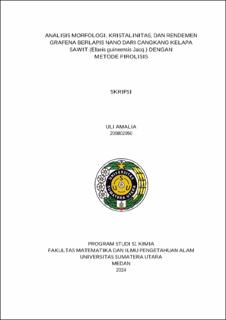Analisis Morfologi, Kristalinitas, dan Rendemen Grafena Berlapis Nano dari Cangkang Kelapa Sawit (Elaeis Guineensis Jacq.) dengan Metode Pirolisis
Analysis of Morphology, Crystallinity, and Yield of Graphene Nano Sheets (GNS) from Palm Kernel Shell (Elaeis Guineensis Jacq.) Using The Pyrolysis Method

Date
2024Author
Amalia, Uli
Advisor(s)
Siburian, Rikson Asman Fertiles
Metadata
Show full item recordAbstract
Research on the analysis of morphology, crystallinity and yield of Graphene
Nano Sheet (GNS) from palm kernel shell using pyrolysis method has been carried
out. The purpose of this study was to analyze the optimum conditions of temperature
(T) and time (t) pyrolysis in converting palm kernel shell into GNS and to analyze the
morphological properties, crystallinity and yield of GNS from palm kernel shell from
various variations of temperature (T) and time (t) pyrolysis. This research is
laboratory experimental research. The production of GNS from palm kernel shell
raw materials using pyrolysis method varies in temperature (T) and time (t), namely
TPyrolysis-I = 350, 400 and 450 °C; tPyrolysis-I = 2 and 3 hours and TPyrolysis-II = 350 °C;
tpirolysis-II = 1 hour The resulting GBN was analyzed using X-Ray Diffraction (XRD),
Scanning Electron Microscopy Energy Dispersive X-Ray (SEM- EDX), and Fourier
Transform Infrared (FTIR). The results of the analysis showed that the optimum
pyrolysis conditions to produce GBN products with the best crystallinity and
morphology of palm kernel shell were at variations of TPirolysis-I & II = 450 and 350 °C;
tpirolysis-I & II = 3 and 1 hour from the XRD data of GNS showing the presence of weak
and broadened peaks at C (002) 2θ = 24.2° and C (100) 2θ = 44.2° which were
amorphous. The results of the XRD data analysis are supported by SEM-EDX and
FTIR data. GNS has a thin layer sheet-shaped morphology with element abundance
dominated by carbon (C) atoms at 90.54%, and the results of FTIR analysis show an
aromatic carbon sp2 structure at 1565.6 cm-1, and obtained a yield of 17,6 %. All
research data show that GNS can be produced from palm kernel shell raw materials,
thus palm kernel shell waste can be utilized for GNS production on a large scale.
Collections
- Undergraduate Theses [1411]
